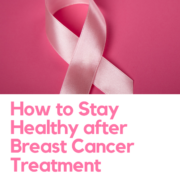How to Stay Healthy after Breast Cancer Treatment
Numerous research studies have shown that avoiding sedentary life and taking regular physical exercise, along with a healthy diet and habits, is essential to prevent breast cancer.
But what about women who have already suffered from this disease and are still in the treatment and recovery phase? Although studies focus on specific sports such as Nordic walking or archery; experts are clear: physical activity can bring many benefits both physically and psychologically.
Fewer Relapses and Higher Quality of Life
According to data from the GEICAM Breast Cancer Research Group, women who remain active after diagnosis have a 67% lower risk of relapse than those with an inactive lifestyle.
In addition, regular exercise improves your quality of life. Exercising helps reduce fatigue and sleep problems. Besides, staying active improves the patient’s mood, increases her sense of well-being and reduces stress and anxiety.
Recovering from Breast Surgery
If there is no edema (swelling) or pain, the patient can return to normal life one week after the surgery. And if everything goes well, she can start playing sports in the first few weeks.
In some cases, however, it may be necessary to put yourself in the hands of a specialised physiotherapist before that. The consequences of the surgery vary depending on whether it has been conservative – the tumour has been removed while maintaining the breast – or a mastectomy has been necessary.
There may be a shortening of the skin between the chest and the armpit that affects the length of the arm. There may also be peripheral nerve-type sequelae, such as pain or lack of sensation. Especially in the case of mastectomy, but sometimes it also happens with conservative surgery.
“Physio” to Prevent Lymphedema
When it has also been necessary to remove the lymph nodes (lymphadenectomy), there is a 10% chance that the patient will suffer from lymphedema, a risk that increases to 20-25% if radiotherapy is also performed in the armpit, according to data from the Spanish Association Against Cancer.
Lymphedema consists of an accumulation of fluid in the arm, which causes an increase in its perimeter, heaviness, hardening, pain and difficulty in moving it.
In cases of lymphadenectomy and mastectomy 3 weeks or a month of physical therapy aimed at mobilizing the arm to prevent and treat these problems are recommended.
The specialized physiotherapist will adapt the treatment to each patient and then recommend which sports are most indicated in each case. As well as the stretching, relaxation and breathing exercises that can be done at home.
Exercising Strengthens the Immune System
What if the patient has to have radiation or chemotherapy? In this case, the treatment does not influence the possibility of starting physical exercise, although it is recommended to individualize it. In other words, adapt it to the patient’s condition and the physical activity to which she was previously accustomed.
There is evidence when regular practice can improve recovery of defenses, for example, influence of chemo is reduced.
Decrease the Side Effects
The breast cancer specialist also points out that after surgery most patients have to follow hormonal treatment for 5 years which causes a series of metabolic changes.
It can cause different disorders such as increased cholesterol, mood swings, etc. And it has been proven that exercising can help regulate these changes, reduce the side effects of hormone treatment or at least lower its intensity.
Better Aerobic Sports
As for what type of sports can be most recommended; there are none that are contraindicated, but that they should be evaluated individually.
The recent scientific evidence is in favor of aerobic and endurance exercise. Increased body mass index is associated with an increased risk of recurrence (reoccurrence of the disease) due to the mechanism of hormone production. And the weight control achieved with aerobic exercise is associated with the prevention of relapses.
Walking at a good pace, running, cycling or swimming are some of the aerobic exercises. Being lower intensity sports, but performed for longer, they are beneficial for the cardiovascular system and lung capacity, and improving endurance.
Besides, doctors highlight swimming, since in addition to mobilizing the arms, in water exercises the impact on the joints is cushioned, an aspect that must be taken into account if the patient suffers from osteoporosis or osteoarthritis as can happen after menopause. Swimming does not harm anyone.
Nordic Walking
I’m sure you’ve seen quite a few people walking around town with sticks lately. It’s called Nordic Walking and several studies have shown that this sport, which is affordable and easy to practice and can also be very beneficial in the recovery from breast cancer.
A publication by a group of Italian scientists describes that Nordic walking activates the trunk and upper limbs when walking, increasing their range of motion and the body’s total muscle strength.
By working the upper body (arms, shoulders, back), it improves blood circulation in the arms, stimulates lymphatic drainage and can improve secondary lymphedema in breast cancer.
The specialist recalls that lymphedema and alterations in local sensation, as well as the risk of deep vein thrombosis due to local circulation being affected are the main sequelae in the case of mastectomy if accompanied by lymphadenectomy.
And to prevent these problems, it may be advisable to do any exercise that is aimed at weight control and improving the venous return of the extremities”.
About the author: Nicholas H. Parker is a nutritionist and allergy expert. Besides, he has his own column on the site, hire essay writer service. So he can share his experience with others. In this case, Nicholas has an opportunity to deal with work and hobbies simultaneously.




